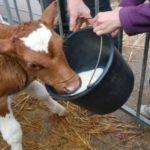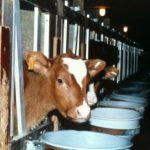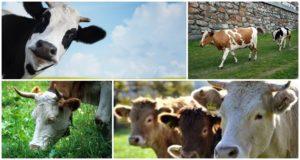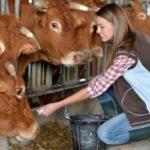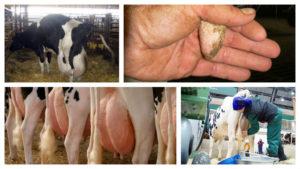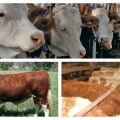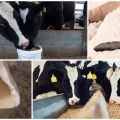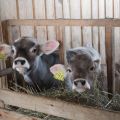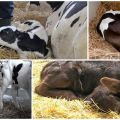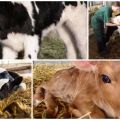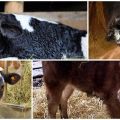Scheme and rules for feeding newborn calves at home
Colostrum is the calf's first food, it gets it right after birth. It should be easily digestible, nutritious and energetic. Colostrum meets these requirements. Consider when and how much colostrum newborn calves should drink, how to properly feed them by hand, and what should not be given to young calves after birth.
The benefits of colostrum
Colostrum is formed in the udder of a cow before calving and is stored in it for 4-6 days after it. It was created by nature to prepare the calf for independent nutrition and life. It contains all the components necessary for a newborn animal: water, proteins, carbohydrates, fats, mineral elements, vitamins, bioactive substances.
In addition, colostrum contains substances that are unique to the secretory fluid - immunoglobulins, active leukocytes and lymphocytes, lysozyme, growth stimulants, interferon, lactoferin, prebiotics, cytokines.
Colostrum is creamy or yellowish in color, thicker than milk, salty taste. Every day its composition changes, it becomes thinner and more transparent.
Desoldering scheme
The mode and amount of animal colostrum that has entered the body affects health, resistance to diseases, and the development of the newborn. From a natural point of view, the best option for newborns to obtain colostrum is sucking. In this case, he stays with the cow, sucking the liquid directly from her udder. Colostrum not only helps the calf's body to adapt, but also quickly normalizes the condition of the cows after giving birth. When it comes to the baby from the udder, it remains uncontaminated, its temperature is optimal. With this method of feeding, young animals are less sick with gastrointestinal diseases.
For the first time after birth, a calf at home should drink colostrum no later than an hour after birth. In the next 2-3 days, he should receive food 4-5 times a day, on the following days - 3-4 times a day.
To drink a calf correctly by hand, you need to give it colostrum according to the norms: on the first day - 17-20% of body weight, in the next - 20-24%.
It should be borne in mind that if the newborn drinks more than they should, this can lead to an upset stomach. Weak or small calves are best served with less volume, but more often. Drinking colostrum should be at body temperature, cold colostrum should be heated to a warm state.The table clearly shows the desoldering scheme.
| Drinking days | Number of drinks | Colostrum volume in% of body weight |
| 1st day | 5 times | 17-20 % |
| 2-3rd day | 4-5 times | 20-24 % |
| 4-7th day | 3-4 times | 20-24 % |
How to change the calf feeding system
After a week of feeding with colostrum, the animals are transferred to whole milk. You can feed it naturally or drink milk from a bottle. First, they drink 1 liter per day, then the rate is increased to 5-6 liters per day. According to this scheme, they feed up to 1.5-2 months, when they begin to introduce products for adult animals into the diet.
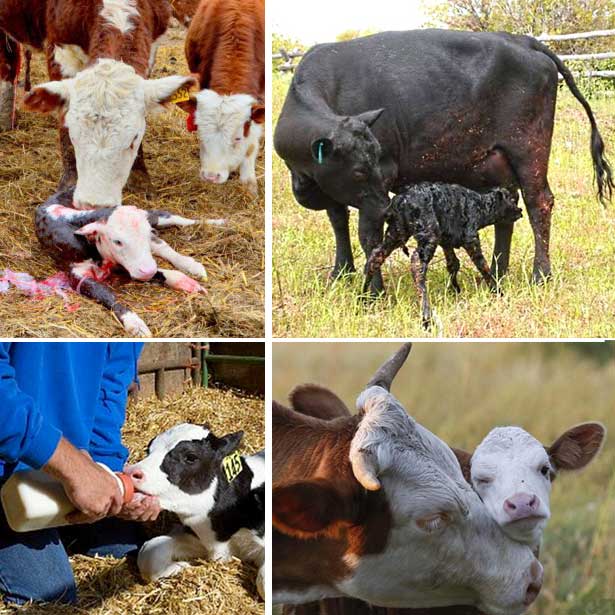
Calves up to 1 month old need to drink milk in small portions, if given a lot at a time, it will linger in the digestive tract, disorders are possible. Young calves are also fed with fermented milk, and towards the end of the suckling period they switch to a fat-free product.
Feeding calves with water: proper feeding
They begin to drink water in parallel with milk. It is necessary to accustom the animal to water, since a lack of fluid leads to an increase in the acidity of the stomach juice, problems with the work of the digestive tract. Calves up to 2 weeks of age need to boil water, after this age they can be fed raw.
You can drink from a bucket or bottle with a nipple, 1.5-2 hours after drinking milk. The amount of water is not more than 1 liter for animals up to 2 weeks, after which it is necessary to gradually increase the volume to 2 liters after each feeding. In addition to water, you can drink chatters from water and cattle feed, which increase appetite, speed up metabolism.
Feeding calves with milk powder
When calves are 10 days old, milk replacer can be started. 1 kg of dry mix diluted in water replaces 10 liters of fresh one. You need to prepare the mixture from 1 kg of dry raw materials and 8-9 liters of clean water.
The dry mix contains skim milk, ground grain, whey and buttermilk. Antibiotics are added to some mixtures in production to normalize bowel function. The advantage of feeding calves with such a mixture is that they cannot contract diseases from the mother, and also that it contains more minerals than natural milk.
Another substitute that can be used to feed calves is milk powder. This is a dried milk powder, which contains more vitamins and minerals and has a greater nutritional value. For drinking it must be diluted with water according to the scheme: powder in the amount of 0.5% of the weight of the animal, liquid in the amount of 4% of the weight. The dignity of a substitute is that its components do not change, as happens with fresh milk, the composition of which can change depending on the conditions in which the animal lives. In addition, the powder has a long shelf life and is much cheaper.
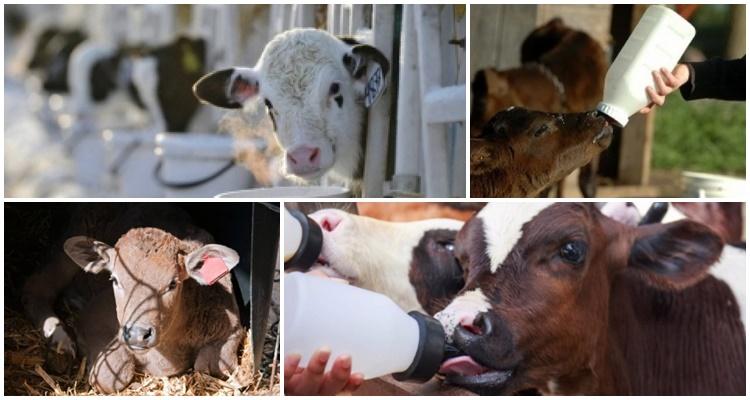
Calf Vitamin Supplements
To normalize life processes, calves need to be given mineral and vitamin supplements. To strengthen immunity and accelerate growth - "Gamavit", "Katazol", "Nucleopeptide". The drugs are injected. To improve digestive processes and gain weight, young animals are given premixes, for example, the Gavryusha premix. When hypovitaminosis occurs, inflammation of the mucous membranes, impaired regenerative functions and hair loss, they are administered in the form of injections "Tetravit" and "Eleovit". For newborn calves, you can use the Selemag complex.
Supplements containing proteins, vitamins, fat, fiber, ash, sugar and amino acids are also used. They are added to compound feed.
What shouldn't be given?
During the period of feeding with colostrum, nothing other than water should be given. It is forbidden to drink cold water. Also, calves should not be fed milk from cows with mastitis and any infectious diseases.Equipment - buckets, bottles for drinking, must be clean, after each feeding they must be rinsed with water and dried, and from time to time treated with disinfectants.
When transferring to adult feed, you should not feed moldy hay, bread and flour products, potatoes and beets in the same mixture (this leads to bloating). When the calves start grazing in the pasture, you need to make sure that no poisonous plants come across among the grass. The time from birth of calves to weaning is an important period in the life of cattle. Correct feeding of young animals ensures their normal development, growth and weight gain, health, and strong immunity. How the young growth will develop depends on its productivity and production value.
